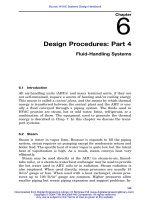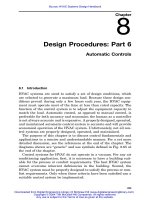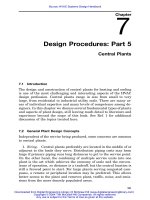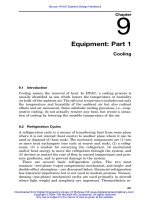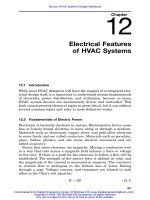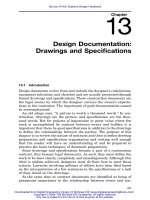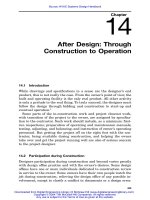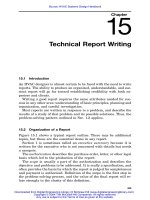HVAC Systems Design Handbook part 12
Bạn đang xem bản rút gọn của tài liệu. Xem và tải ngay bản đầy đủ của tài liệu tại đây (117.76 KB, 14 trang )
397
Chapter
12
Electrical Features
of HVAC Systems
12.1 Introduction
While most HVAC designers will have the support of a competent elec-
trical design staff, it is important to understand certain fundamentals
of electricity, power distribution, and utilization, because so many
HVAC system devices are mechanically driven and controlled. This
book cannot present electrical topics in great detail, but it can address
several common topics and refer to more definitive works.
12.2 Fundamentals of Electric Power
Electricity is basically electrons in motion. Electromotive forces cause
free or loosely bound electrons to move along or through a medium.
Materials such as aluminum, copper, silver, and gold allow electrons
to move freely and are called conductors. Materials such as porcelain,
glass, rubber, plastics, and oils resist electron movement and are
called insulators.
Forces that move electrons are magnetic. Moving a conductive wire
in a way that cuts across a magnetic field induces a force or voltage
in the wire. If there is a path for the electrons to follow, a flow will be
established. The strength of the motive force is defined in volts, and
the magnitude of the current is measured in amperes. The resistance
to current flow is analogous to the friction loss of water flowing
through a pipe. Voltage, current, and resistance are related to each
other in the Ohm’s law equation
E ϭ IR (12.1)
Source: HVAC Systems Design Handbook
Downloaded from Digital Engineering Library @ McGraw-Hill (www.digitalengineeringlibrary.com)
Copyright © 2004 The McGraw-Hill Companies. All rights reserved.
Any use is subject to the Terms of Use as given at the website.
398 Chapter Twelve
where E ϭ voltage, V
I ϭ current, A
R ϭ resistance, ⍀
Power, defined as a force moving through a distance per unit time,
is defined electrically by the equation
P ϭ EI
where P ϭ power in watts.
In direct-current (dc) systems, the voltage is applied in one direction
only. In alternating-current (ac) systems, the voltage changes direction
on a continuous basis; 60-Hz systems are common in the United
States, while 50-Hz systems are common in Europe. (Hz ϭ hertz, or
cycles per second.)
12.3 Common Service Voltages
Many different voltages have been used over time for electrical service
in and to buildings and complexes. Forty to fifty years ago, many—if
not most—building distribution was single-phase at 120/240 V. A
high-leg delta scheme was used to feed single- and three-phase re-
quirements. Current practice tends toward three-phase service in
most locales. Smaller systems focus on 120/208 V, larger systems on
277/480 V. Control systems usually step down to 24 V.
Utility and campus distribution voltages are often found at 2300,
4160, 7200, and 12,470 V. Large motors are sometimes selected for
2300 or 4160 V if that works well with the distribution system. There
is a sharp increase in the complexity and cost of electrical gear above
5 kV (5000 V) which precludes much use of the higher voltages. The
HVAC designer may occasionally encounter 2300- or 4160-V motors
on chillers or large pumps. Competent help is needed in specifying
electrical gear and protection for such applications.
Most motors and other user devices are rated to perform acceptably
at nameplate voltage plus or minus 10 percent. Power companies gen-
erally commit to line voltage plus or minus 5 percent, with brownouts
and outages allowed. This explains the common motor voltage versus
system voltage relationships typically encountered. Table 12.1 illus-
trates these voltage rating–delivery relationships. It becomes appar-
ent why industry has evolved away from the earlier 220/440-V motor
ratings. The 240 /480-V delivery systems were simply out of the motor
service range much of the time.
Electrical Features of HVAC Systems
Downloaded from Digital Engineering Library @ McGraw-Hill (www.digitalengineeringlibrary.com)
Copyright © 2004 The McGraw-Hill Companies. All rights reserved.
Any use is subject to the Terms of Use as given at the website.
Electrical Features of HVAC Systems 399
TABLE
12.1 Electrical Voltages
Nominal
line voltage, V
Probable
service range, V
Nominal
motor rating, V
Motor
operating range, V
120 126– 114 115 126.5– 103.5
208 218– 197 200 220– 180
240 252– 228 230 253– 207
480 504– 456 460 506– 414
2300 2415–2185 2200 2420–1980
4160 4370–3950 4000 4400–3600
12.4 Power Factor
In ac systems where the voltage is constantly changing from positive
to negative and back again, current flow often lags the voltage. This
is particularly true of inductive loads such as motors, transformers,
and magnetic fluorescent lighting ballasts (a type of transformer), all
of which involve copper wire wound around a steel core.
As the voltage (electromotive force) propels electrons along the con-
ductor, the electrons tend to momentarily gather or store themselves
in the inductive body. It is as if the voltage has to tell the current to
catch up. The net effect is that the true power (instantaneous voltage
times instantaneous amperage) is usually less than the apparent
power (maximum voltage times maximum amperage). The power fac-
tor, denoted by PF, is then defined as the cosine of the phase angle
between the voltage and the current. The power-defining equation for
three-phase power evolves to
Power ϭ EI͙3(PF) (12.2)
Since parasitic power losses in power distribution systems, as well
as conductor capacity, are based on current flow:
22
Power loss ϭ (current) (resistance) ϭ IR
having a greater than necessary current flow out of phase with the
voltage is detrimental to the overall electric system. Utility companies
often impose a cost penalty on consumers with poor power factors
(usually less than 0.90). The biggest contributors to a poor power fac-
tor are inductive devices which are only partially loaded. The HVAC
designer should avoid grossly oversized motors. The power factor is
corrected by connecting capacitors to the line to offset the inductive
effect. Capacitors have the opposite effect on current-voltage relation-
ships from inductances. Sometimes motor specifications include ca-
pacitors. Or the capacitors may be installed in the motor control cen-
ter. Less often, a bank of capacitors will be installed at a central point
Electrical Features of HVAC Systems
Downloaded from Digital Engineering Library @ McGraw-Hill (www.digitalengineeringlibrary.com)
Copyright © 2004 The McGraw-Hill Companies. All rights reserved.
Any use is subject to the Terms of Use as given at the website.
400 Chapter Twelve
in the electric distribution system. Distributed power-factor correction
is usually less expensive than central or consolidated correction. Cen-
tral correction usually requires automated control of on-line capaci-
tance, since the magnitude of on-line inductance varies with time.
12.5 Motors
Electric motors are devices which convert electric energy to kinetic
energy, usually in the form of a rotating shaft which can be used to
drive a fan, pump, compressor, etc. Single-phase motors are commonly
used up to 3 hp, occasionally larger. Three-phase motors are preferred
in electrical design for
3
⁄
4
-hp motors and larger, since they are self-
balancing on the three-phase service. Motors come in various styles
and with different efficiency ratings. The efficiency is typically related
to the amount of iron and copper in the windings; i.e., the more iron
for magnetic flux and the more copper for reduced resistance, gener-
ally the more efficient the motor. Words such as standard and pre-
mium efficiency are common. Inverter duty implies a motor built to
withstand the negative impacts of variable-frequency drive. Open
drip-proof (ODP) motors are used in general applications. Totally en-
closed fan-cooled (TEFC) motors are used in severe-duty environ-
ments. Explosion-proof motors may be needed in hazardous environ-
ments.
Motors are typically selected to operate at or below the motor name-
plate rating, although ODP motors often have a service factor of 1.15,
which implies that the motor will tolerate a slight overload, even on
a continuous basis. Since motors are susceptible to failure when they
are operated above the rated temperature, care must be taken in mo-
tor selection for hot environments such as downstream from a heating
coil. For altitudes above 3300 ft, motor manufacturers typically dis-
count the service factor to 1.0.
Motor windings are protected by overload devices which open the
power circuit if more than the rated amperage passes for more than
a predetermined time. This raises an interesting issue for a motor
assigned to drive a fan that has a disproportionately high moment of
rotational inertia. On start-up, a motor draws much more than the
full-speed operating current. The time required to bring a fan up to
speed may be too long if the motor doesn’t have enough torque to both
meet the load and accelerate the fan wheel. If the motor doesn’t come
up to speed within 10 to 15 s, it is likely that the motor protection
will cut out based on the starting amperage. A motor sized tightly to
a fan load may never get started. Therefore, it is important to size a
motor for both load and fan wheel inertia. Fan vendors can help with
Electrical Features of HVAC Systems
Downloaded from Digital Engineering Library @ McGraw-Hill (www.digitalengineeringlibrary.com)
Copyright © 2004 The McGraw-Hill Companies. All rights reserved.
Any use is subject to the Terms of Use as given at the website.
Electrical Features of HVAC Systems 401
this concern. This problem is particularly common on large boiler in-
duced-draft fans where the dense-air, cold-start-up condition requires
much more driver power than the hot operating condition.
1
12.5.1 Motor rotation
In single-phase motors, the direction of motor rotation is determined
by the factory-established internal wiring characteristics of the motor.
Changing the connection of leads to the power source may have no
effect on the direction of rotation. To make a change requires a change
in an internal connection as directed by the manufacturer.
In polyphase motors, a lead sequence is established at the power
plant. The motor presents three sets of lead wires which are connected
to the three phases of the service. If a three-phase motor is found
running backward, all that is needed to change the direction is to
exchange any two leads.
12.6 Variable-Speed Drives
One of the most useful electrical developments in recent years has
been the ac variable-frequency drive (VFD) for motor speed control.
Electric speed control of motors is not a new concept—dc drives have
been used for decades in the industrial environment—but low-cost ac
drives suitable for the HVAC market are a relatively new product.
These new drives typically use electronic circuitry to vary the output
frequency which in turn varies the speed of the motor. Since the power
required to drive a centrifugal fan or centrifugal pump is proportional
to the cube of the fan or pump speed, large reductions in power con-
sumption are obtained at reduced speed. These savings are used to
pay for the added cost of the VFD on a life cycle cost basis. A quality
VFD usually obtains greater energy savings than does a variable-pitch
inlet vane or other mechanical flow volume control. In low-budget pro-
jects, the owner may forgo the higher-quality VFD service in favor of
the lower-first-cost inlet vane damper for fans, or modulating-valve
differential pressure control for pumps.
In applying a VFD to a duty, several factors need to be considered:
1. The VFD needs to be in a relatively clean, air conditioned envi-
ronment. Since it is a sophisticated electronic device, particulates in
the ambient air, wide swings in ambient air conditions, temperatures
above 90ЊF, and humid condensing environments are all threatening
to drive life expectancy.
2. The drive should be matched to the driven motor. Reduced motor
speeds relate to reduced motor cooling while internal motor energy
Electrical Features of HVAC Systems
Downloaded from Digital Engineering Library @ McGraw-Hill (www.digitalengineeringlibrary.com)
Copyright © 2004 The McGraw-Hill Companies. All rights reserved.
Any use is subject to the Terms of Use as given at the website.
